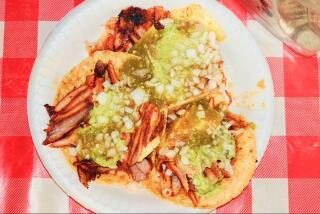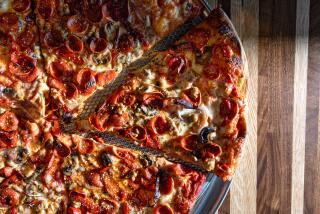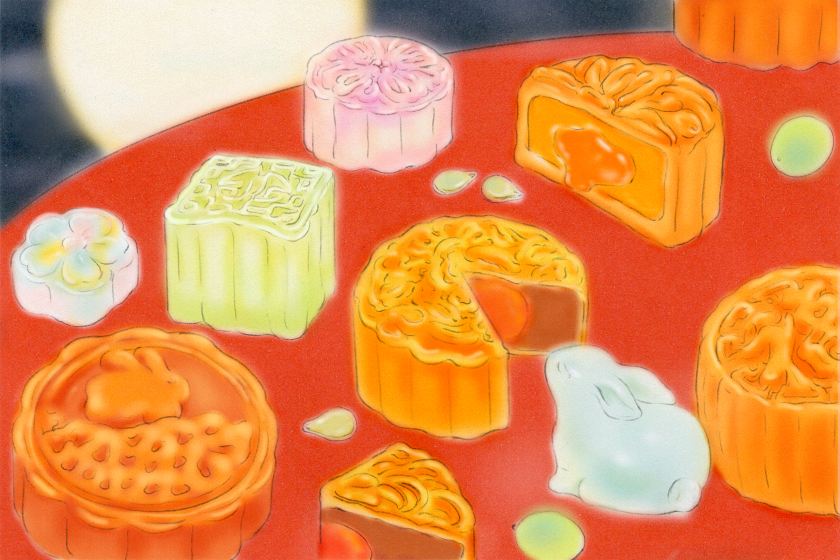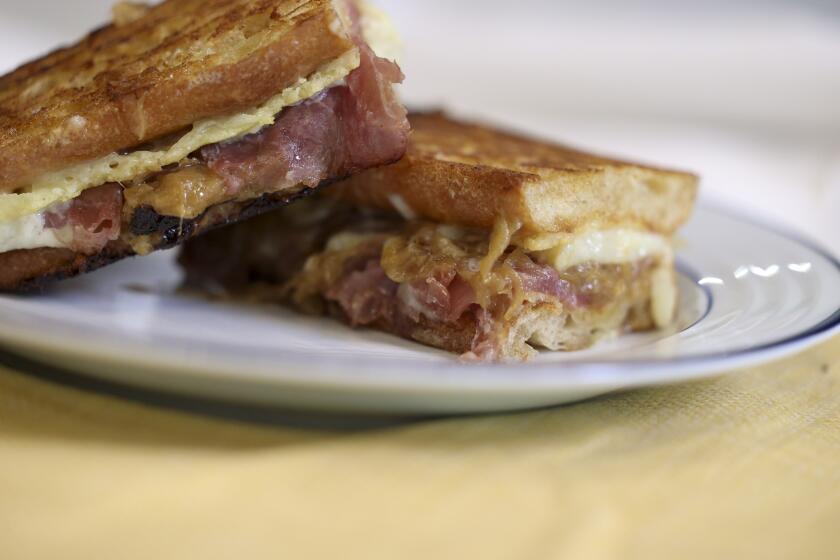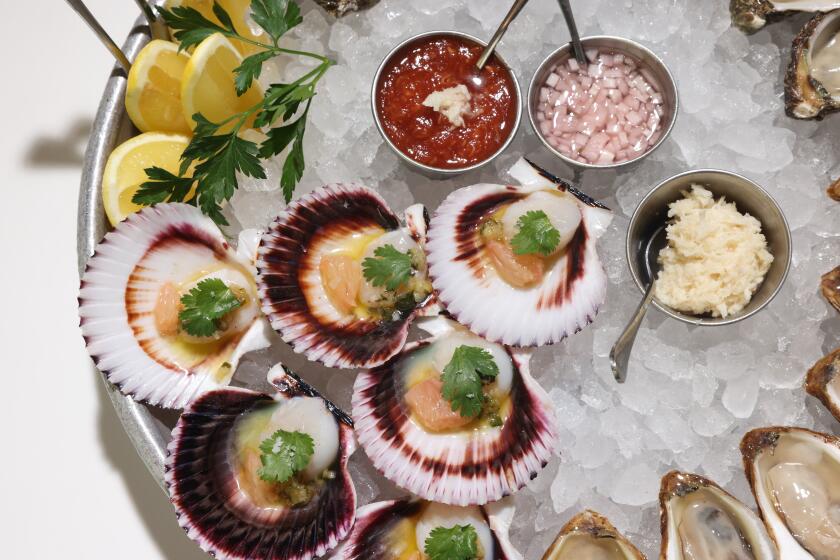Unforgettable
THEY say that sometimes the best gift is one we give ourselves. As cooks, we know that a gift of food is even better when it can be shared with others. And it’s better still when it involves flipping crepes, filling pastries and roasting duck, tasks that might sound like chores to some people, but which fill us with a quiet joy (and the house with wonderful smells).
So with this Christmas Eve falling on a Sunday, why not give yourself an early present and cook a nice dinner for some people you care about?
It doesn’t have to be anything major, just a quiet meal for four good friends, a moment of calm in the midst of the hectic holiday season. For one evening you can forget all the school pageants, office parties and open houses. Just sit back, enjoy the blinking lights and carols and eat good food.
You know, something like roast duck with turnips, the bird’s skin crisp with a hint of spices and orange, preceded by crunchy little pastries stuffed with a rich salad of Dungeness crab and radishes, and followed by a dessert of silken crepes filled with a fragrant grapefruit cream. Add some oysters to the first course and serve watercress salad and cheeses so you can linger over the red wine before dessert and you’re all set.
It’ll be fun -- and not just the eating part, but the cooking part as well.
Given time and the right frame of mind, there’s something about the shopping, the chopping, the alternating moments of hurry and calm that is intensely enjoyable, even relaxing. And given the normal pace of life in this pre-holiday run-up, those are things that seem mighty welcome.
You can do the whole meal in only a couple of hours -- not counting the roasting of the duck, which actually takes only a few minutes of active attention. And you can either do all the work at once or split it up so you can putter at your pleasure. Wrap some presents; flip some crepes. Hang some stockings; bake some pastry shells. You get the picture.
Here’s how I’d do it: Salt the duck and set it aside several days in advance. The day before the dinner, bake the pastries. Christmas Eve morning, prepare the crepe batter and the filling. A little later, take half an hour to make the crab salad and clean and blanch the turnips. That leaves you with about an hour more of work to finish the meal.
And what a meal.
Roast duck is a dish that seems made for such intimate dinners. First, because it’s delicious -- skin that is browned and crisp to the point of crackling, and meat that is moist, rich and faintly gamy.
But almost as important, the dish is perfect because it’s inconvenient to serve roast duck for a group that’s any bigger than four. There’s just not much meat on a duck -- particularly when compared to a plump little chicken or a great big turkey. And what meat is there is spread pretty sparsely over a large frame; a duck is too big to roast two at a time in anything but a restaurant setting.
So much the better, though -- because so few people serve a whole roast duck anymore, that just makes it all the more memorable when you do.
Crisp, moist, perfect
STILL, there are a few things to keep in mind when roasting a duck. The current fashion is to serve medium-rare duck breast, but forget about that when you’re roasting a whole bird. The leg is full of sinew that must be cooked to at least medium to become tender. The laws of physics dictate that serving a medium-rare leg and a medium breast from the same bird at the same time is a physical impossibility.
So just forget about fashion and cook your duck to medium or even medium-well. That’s no sacrifice. Because a duck’s breast is “dark meat,” it tastes wonderful way beyond the point at which a turkey or chicken would have dried to sawdust. During my testing, one duck got away from me and cooked to 185 degrees, but the breast meat was still moist (though the area around the knee was a little dried out).
The other problem a lot of cooks have with duck is that it’s pretty fatty. Unlike most poultry, which have been bred to be lean, ducks still have a fairly thick layer of fat just beneath the skin (and after a long walk in the wetlands last week in a brisk breeze, I can certainly understand why).
That fat is one of the reasons the skin gets so crisp and the meat stays so moist, but it can also be a hurdle if you’ve never roasted a duck. A badly prepared duck can be pretty greasy.
Cooks have come up with all sorts of tricks to render the fat. Some advocate steaming the bird first, then roasting it to crisp the skin. Some recommend high-heat roasting: In “Simply French,” Joel Robuchon calls for a 425-degree oven.
To my mind, both of these have significant drawbacks. The first is cumbersome, involving transferring a hot bird from one pan to another -- and that’s even if you somehow are able to find a steamer big enough to hold a whole duck.
High-heat roasting does work well, but it also smokes and spatters like the dickens. Use it only if you have a restaurant-quality exhaust fan (and a restaurant-quality galley slave to scrub the roasting pan afterward).
Instead, I prefer roasting duck at a low temperature for a long time, then turning up the heat at the finish to crisp the skin.
This is the same way I roast a pork shoulder, which also has a good amount of fat beneath the skin. Prick holes in the skin at the base of the breasts and thighs before cooking to allow the rendered fat to escape.
There will be plenty of this -- I roasted three ducks last week and wound up with almost two cups. Draw this off repeatedly during roasting so it doesn’t scorch and you’ll have a really lovely cooking fat, perfect for frying potatoes.
A bulb baster works well, but it’s a lot easier to remove the duck and the roasting rack from the pan and simply pour the fat off. Be sure to leave the browned bits behind in the pan; you’ll want them to flavor the roasted turnips.
Duck with turnips is a classic French combination, though it’s traditionally prepared as a braise, not a roast. No matter, the flavors and textures work perfectly: The rich, meaty duck and the creamy, slightly bitter turnips are made for each other, especially after the turnips have browned and glazed in the duck fat.
To play up the combination, I rubbed the duck with a mixture of spices and orange zest ground to a powder. This is a flavored spin on the Judy Rodgers-inspired pre-salting that worked so well with turkey when I experimented with it for Thanksgiving. If anything, it works even better this way: The salt really does carry hints of the flavor all the way through the meat.
What to drink? Burgundy or Pinot Noir complement it wonderfully, but to my mind, the spicing and orange peel perfume speak equally well to a Syrah.
Before the duck, and after
BECAUSE it would be unthinkable in my house to have any winter celebration without Dungeness crab, I’d start the menu with crab puffs. They’re simple to make -- nothing more than classic choux pastry stuffed with a salad of crabmeat and sliced radishes and bound with a little mayonnaise.
“Simply made?” I hear you ask, “With homemade cream puff dough?” To be honest, I’d forgotten just how easy these are to make, and even how much fun.
The dough comes together in a few quick minutes: Melt butter and water, beat in flour, then beat in the eggs.The only tricky part is making sure to dry the dough thoroughly in the pan before adding the eggs -- that’s what makes the dough light and the puffs hollow.
And there’s something about watching them rise that is purely magical. From a squat little dumpling, the dough swells and puffs in the oven so magnificently that it looks as though it’s ready to float off the cookie sheet.
You can make these pastries a day in advance. Just store them uncovered on the cooling rack at room temperature so they’ll stay crisp.
On a separate platter, serve oysters. I get mine mail-order from Taylor Shellfish (www.taylorshellfish.com; four dozen assorted are $48 plus shipping). I get my crab from the live tanks in Chinese and Southeast Asian markets.
Serve the first course with -- what else? -- sparkling wine or Champagne.
Follow the duck with a salad -- toss peppery watercress with a vinaigrette spiked with some of the hot duck fat -- after all that rich, a little crisp and tart will be welcome. Serve it with an assortment of cheeses, which will let you enjoy the red wine a little longer.
Finish the meal with a luxurious plate of eggy crepes filled with a rich combination of cream cheese, sour cream and whipping cream scented with grapefruit zest. Garnish with honey-sweetened grapefruit segments. It’s like a heavenly grown-up version of a blintz.
Make both the crepe batter and the filling in the same blender. Do the batter first, strain it into a jar to rest, rinse the blender and then make the filling. The whole process shouldn’t take more than 10 minutes.
In fact, you can prepare all three elements in advance -- cook the crepes, blend the filling and marinate the grapefruit segments -- and then assemble the dessert in minutes just before serving.
If you want to serve a wine with this dessert, you might as well get all Niles-and-Frasier-ish and pour a sweet, nutty Oloroso sherry.
After that, serve some coffee and send everyone on their way. There will be more presents in the morning, but none better than this one.
*
Dungeness crab puffs
Total time: 1 hour, 50 minutes
Servings: About 4 dozen 1-inch puffs
Note: This dough is my standard savory pate a choux, which I learned from Madeleine Kamman.
Pastry dough
1/4 cup ( 1/2 stick) butter, diced
1/4 teaspoon salt
Pinch sugar
Pinch white pepper
1/2 cup sifted flour
3 eggs, lightly beaten
Butter
1. Position a rack in the upper third of the oven and heat the oven to 400 degrees. In a small saucepan, bring one-half cup water, butter, salt, sugar and white pepper to a boil, and simmer until the butter is completely melted and the mixture looks milky, about 2 to 3 minutes.
2. Remove the pan from the heat and all at once dump in the flour. Stir until a rather firm ball forms.
3. Dry the dough by returning the pan to medium-low heat and cook the dough, stirring constantly, flattening the ball to expose as much of the surface as possible to the heat. Cook until you see little bubbles of butter oozing from the paste and a sandy film of paste appears on the bottom of the pan, 5 or 6 minutes.
4. Remove from the heat and beat in the eggs, about a third at a time, stirring briskly to incorporate the egg into the dough as quickly and thoroughly as possible before adding another portion of egg. Stir vigorously. At first, the mixture will loosen and separate, but as you continue beating, it will come back together, thicken and become shiny and sticky.
5. Butter a cookie sheet generously and rinse it under cold water. (The water will evaporate while the puffs bake and prevent the bottoms from scorching.) Fit a plain nozzle into a pastry bag and fill the bag with the dough. Pipe balls about 1 inch in diameter onto the cookie sheet, leaving about 2 inches in between for expansion during cooking. You can also use two spoons to scoop out the dough and form it into balls.
6. Bake the puffs until they are dry and brown, about 30 minutes. Use a paring knife to cut a slit in each puff, then return them to the oven for 5 to 10 minutes to finish browning and drying. Do not let them scorch.
7. Remove the puffs to a wire rack and let them cool. The puffs can be prepared 8 hours in advance and stored on the wire rack at room temperature.
Dungeness crab salad
6 radishes
1/2 pound Dungeness crab meat
1/4 cup mayonnaise
1 tablespoon snipped chives
1 1/2 teaspoons minced
tarragon
1/2 teaspoon tarragon vinegar
Salt
1. Cut the radishes in half and then cut them crosswise in moderately thin slices. They should be thick enough that they crunch, but not so thick they dominate the crab. Combine the sliced radishes, crab, mayonnaise, chives, tarragon and vinegar in a mixing bowl and stir to combine. Taste and add salt if necessary. You should have about 2 cups of salad. (The recipe can be made to this point and refrigerated, tightly covered, up to 8 hours in advance.)
2. Slice the top third off of each cream puff shell using a serrated knife. Pull out any moist dough from the center and discard (the better you dry the dough after you’ve added the flour, the less you’ll have to throw away).
3. Spoon a heaping teaspoon of crab salad into the center of each shell and replace the lid. It should sit jauntily on top. Serve within an hour.
Each crab puff: 30 calories; 2 grams protein; 1 gram carbohydrate; 0 fiber; 2 grams fat; 1 gram saturated fat; 20 mg. cholesterol; 41 mg. sodium.
*
Crispy spiced duck with roasted baby turnips
Total time: 3 hours, 35 minutes, plus 2 1/2 days refrigeration
Servings: 4
Note: If you can’t find the baby turnips at the farmers market or Japanese turnips (kabu) at a grocery, you can use four large turnips, peeled and cut in thick wedges. The duck must be started two days in advance.
1 tablespoon coarse salt
1 teaspoon black peppercorns
6 whole juniper berries
6 whole allspice
Zest of 1 orange
1 (4- to 5-pound) duck
1 orange
20 baby or Japanese turnips, peeled and all but 1/2 inch of tops removed
1. In a blade coffee grinder, grind the salt, peppercorns, juniper berries, allspice and orange zest to a fine powder.
2. Rinse the duck and pat it dry. Remove the neck, head, feet and wingtips if necessary. Liberally season the duck all over with the spice mix, rubbing to ensure it sticks. Place the duck in a 1-gallon sealable plastic bag and refrigerate for two days.
3. On the morning of the dinner, remove the duck from the bag, place it on a small platter and put it in the refrigerator, uncovered, to air-dry.
4. About three hours before dinner, heat the oven to 325 degrees. Use a carving fork or trussing needle to pierce the duck skin in several places at the base of both breasts and at the base of both thighs. Be very careful that you pierce the skin, but not the meat. Quarter an orange and stick it in the cavity.
5. Place the duck breast-side up on a rack in a heavy roasting pan and put it in the oven. Check on it from time to time and pour off any fat that collects in the pan. Roast until a thermometer inserted in the deepest part of the thigh reaches 170 degrees. This can take anywhere from 1 1/2 hours for a small 4-pound duck to about 2 1/2 hours for a big 5 1/2 pounder. If you find that your duck has cooked too quickly -- if it gets to 170 degrees before you’re ready -- simply remove it from the oven and set it aside in a warm place.
6. While the duck is cooking, boil the turnips in salted water until they are just tender enough to pierce easily with a small knife, about 10 minutes. Drain and pat dry.
7. When the duck has reached 170 degrees, increase the oven heat to 450 degrees, add the turnips to the roasting pan and cook until the duck is well-browned and the temperature in the thigh is 180, about 20 minutes. Shake the pan every couple of minutes to roll the turnips around.
8. Remove the duck from the oven and set it aside in a warm place for 10 minutes before carving. Do not cover the duck or the skin will lose its crispness. Return the roasting pan with the turnips to the oven to finish browning.
9. Carve the duck and serve each piece with the turnips alongside.
Each serving: 724 calories; 40 grams protein; 7 grams carbohydrates; 2 grams fiber; 58 grams fat; 20 grams saturated fat; 173 mg. cholesterol; 1,383 mg. sodium.
*
Crepes filled with grapefruit cream
Total time: 1 hour, plus at least 30 minutes chilling time
Servings: 4
Crepes
3/4 to 1 cup milk
3 eggs
1 tablespoon sugar
1/4 teaspoon cinnamon
1/2 teaspoon salt
1 cup flour
1/4 cup ( 1/2 stick) butter, melted, plus 1 tablespoon cold for frying
1. Pulse three-fourths cup of milk, one-half cup of water and the eggs two or three times in a blender until smooth. Add the sugar, cinnamon, salt and flour. Blend the batter until smooth. With the blender running, add melted butter. The batter should be the thickness of heavy cream. If necessary, add up to one-fourth cup more milk to correct the thickness. Strain into a covered bowl, and refrigerate at least 30 minutes.
2. Heat an 8- to 9-inch crepe pan or skillet over medium-high heat until a few drops of water skitter and dance when sprinkled on the surface. Add one-half tablespoon cold butter and swirl to distribute it across the surface. Wipe excess butter from the skillet with a paper towel and return to heat.
3. Holding the skillet off the heat with one hand, pour in roughly one-third cup of batter. Swirl quickly across the bottom of the skillet. Pour the excess batter back into the bowl and trim the ragged edge that is left. Return the skillet to the heat and cook until the edges of the crepe begin to brown, about 1 minute. Using a small spatula or table knife, lift the edges of the crepe. Grab the edges with both hands and quickly flip to turn over. Cook the uncooked side just until the crepe slides free in the pan, about 30 seconds. Remove to a plate and cover with wax paper.
4. Repeat until all of the batter is used, using the remaining half tablespoon of butter as needed. You should have about 12 crepes. The crepes can be stored, tightly sealed, overnight in the refrigerator.
Grapefruit cream
2 pink grapefruits
1 tablespoon sugar
1/4 pound cream cheese
1/2 cup sour cream
1/2 cup whipping cream
1tablespoon plus 1 teaspoon honey, divided
1 1/2 teaspoon orange liqueur
1. Zest the peel of half of one grapefruit, and put 1 tablespoon of it in a blender. Add sugar and grind coarsely. Add the cream cheese, sour cream, whipping cream, 1 tablespoon honey and orange liqueur and puree until smooth. Refrigerate, covered, for at least 30 minutes and up to 1 day.
2. Peel the grapefruits, removing all of the white pith. Section the grapefruit from the membrane, squeezing the membrane over a bowl to collect the juice. Add 1 teaspoon honey to the juice and stir to combine. Pour the juice over the grapefruit sections and set aside.
3. Lay a crepe flat and spoon a generous 2 tablespoons of the grapefruit cream into the center. Fold the crepe in half, then in half again, making a wedge. Alternatively, you can fold it like a burrito or a blintz. Repeat, using the rest of the filling.
4. Divide the crepes among four chilled dessert plates, arrange some grapefruit sections over the top and serve.
Each serving: 585 calories; 11 grams protein; 46 grams carbohydrates; 3 grams fiber; 41 grams fat; 24 grams saturated fat; 219 mg. cholesterol; 356 mg. sodium.
More to Read
Eat your way across L.A.
Get our weekly Tasting Notes newsletter for reviews, news and more.
You may occasionally receive promotional content from the Los Angeles Times.
